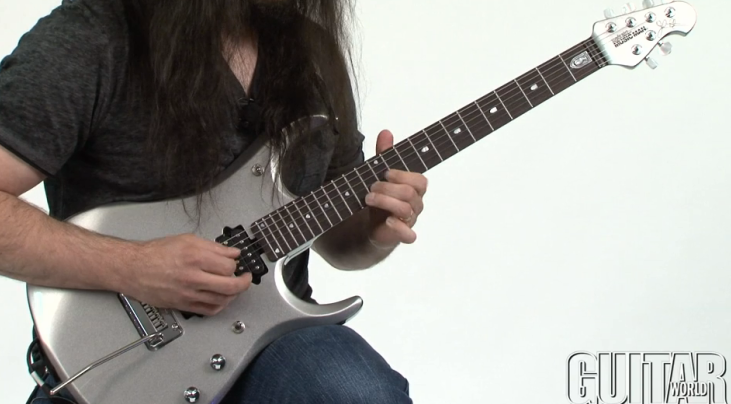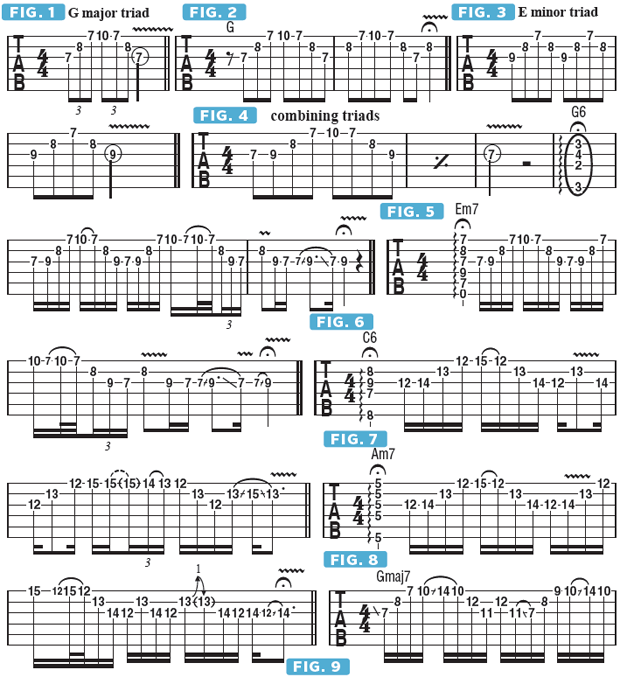Using Triad Arpeggios to Imply More Complex Chord Qualities
Learn how you can utilize simple triadic shapes and patterns in order to imply more complex and varied chord qualities.

This month, I’m going to demonstrate how one can utilize simple triadic shapes and patterns in order to imply more complex and varied chord qualities.
I find this to be a very cool and useful improvisational tool, because you can apply it to playing over either a chord progression that you want to outline melodically or over a static pedal tone or one-chord vamp over which you want to superimpose shifting harmonic colors.
Let’s begin by outlining, and then combining, simple major and minor triads. FIGURES 1 and 2 illustrate the notes of a G major triad—G B D—played in seventh position. The relative minor triad of G major is E minor, and FIGURE 3 depicts an E minor triad played in the same position. Notice that both triads share two of the same notes, G and B.
The “magic” happens when we combine these two triads, and we can utilize and analyze the resulting sound within either a G major or an E minor context. FIGURE 4 shows the two triads combined, so in essence we’ve simply added the E note to the G major triad.
Adding E, the sixth of G, implies the sound of a G6 chord. If we play the same pattern over an E minor tonality, the resultant chordal implication is Em7, as shown in FIGURE 5, and the single-note triadic-based phrases evoke a different harmonic impression.
Let’s now apply this approach to a different tonal center. As shown in FIGURES 6 and 7, the combination of the notes of a C major triad—C E G—and an A minor triad—A C E—result in either a C6 sound, as shown in FIGURE 6, or an Am7 sound, as shown in FIGURE 7. The beauty of this exercise is that it demonstrates how the study of one theoretical concept and its associated single-note patterns can easily be applied to more than one tonal environment.
On a grand scale, this means that the study of one idea can be applied to many different harmonic environments, yielding a broader understanding of music theory as well as heightening one’s fretboard awareness.
- Another great way to use this concept is to combine two different triads that are found within the same tonal center. For example, within the G major scale (G A B C D E F#), one can build a series of seven different triads by starting from each note in the scale and adding thirds above the starting note while remaining diatonic to (within the scale structure of) G major. If we start from B, the third degree of the G major scale, a B minor triad is formed by playing B D F#, notes that
- are all thirds apart, as they occur within the G major.
FIGURE 8 illustrates a phrase that combines G major and B minor triads. We can then apply this approach to the relative minor of G, Em7, as shown in FIGURE 9. When looked at as a whole, combining G major and B minor triads implies a Gmaj13 chord, as shown in FIGURE 10.


Get The Pick Newsletter
All the latest guitar news, interviews, lessons, reviews, deals and more, direct to your inbox!







![Joe Bonamassa [left] wears a deep blue suit and polka-dotted shirt and plays his green refin Strat; the late Irish blues legend Rory Gallagher [right] screams and inflicts some punishment on his heavily worn number one Stratocaster.](https://cdn.mos.cms.futurecdn.net/cw28h7UBcTVfTLs7p7eiLe.jpg)


